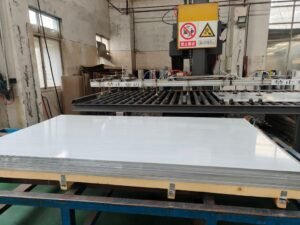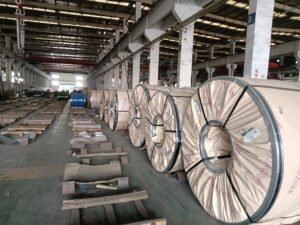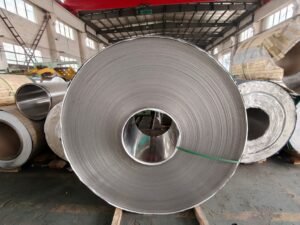Introduction
Choosing the right material for your project can make or break its success, especially when balancing cost and durability. For industries like construction and cookware manufacturing, the decision between carbon steel and stainless steel often comes down to strength, corrosion resistance, and budget constraints.
Understanding the key differences between these materials is essential to making an informed choice. At HnL Steel, we’ve seen how selecting the right steel impacts project outcomes. This guide breaks down the properties, applications, and benefits of each to help you decide with confidence.
Introduction to Carbon Steel and Stainless Steel
When it comes to building or manufacturing, selecting the right material can make or break a project. Carbon steel and stainless steel are two of the most popular choices in industries like construction and manufacturing. Knowing their differences helps businesses pick the best option for durability, cost, and specific use cases.
Choosing between carbon steel and stainless steel isn’t just about preference—it’s about performance. Each material has unique strengths that suit different needs, from heavy structural beams to kitchen equipment. Let’s break down what defines these materials and why the choice matters.
Picking the right material like carbon steel or stainless steel can save costs and boost project success by matching specific application needs.
Defining Carbon Steel: Composition and Basic Characteristics
Carbon steel is primarily made of iron and carbon, with carbon content varying from low to high levels. This range—low (under 0.3%), medium (0.3-0.6%), and high (above 0.6%)—changes its strength and flexibility. It’s often chosen for its toughness in projects like bridges or machinery.
While it’s strong, carbon steel can rust easily without protective coatings. This makes it less ideal for wet or corrosive environments. Still, its affordability keeps it a top pick for many commercial uses.
Defining Stainless Steel: Key Features and Alloy Components
Stainless steel stands out due to its chromium content, usually at least 10.5%, which gives it rust resistance. It also includes nickel or molybdenum in some grades, boosting durability in harsh conditions. This makes it perfect for medical tools, food processing, and marine applications.
Unlike carbon steel, stainless steel resists corrosion, which extends its lifespan. However, it often costs more due to these added elements. Its shiny look also adds aesthetic value in design-focused projects.
Importance of Material Selection in Commercial Projects
Choosing between carbon steel vs stainless steel impacts both budget and project outcomes. For example, a construction firm might save money using carbon steel for structural beams but risk rust over time. Trusted suppliers like HnL Steel help by offering high-quality options and tailored advice for specific industries.
Material grade stocking ensures clients get the right fit, whether for heavy-duty manufacturing or sleek architectural designs. Making an informed choice prevents costly repairs or replacements down the road. Suppliers focused on long-term partnerships prioritize these needs over quick sales.
Overview of Key Decision Factors: Cost, Durability, and Use Cases
Cost is a big factor—carbon steel typically costs less upfront, while stainless steel saves money on maintenance. Durability varies too; stainless steel shines in wet areas, while carbon steel excels under heavy loads if protected. Understanding the differences between carbon steel and stainless steel helps narrow down choices based on environment and stress levels.
Use cases also guide decisions. Carbon steel suits oil pipelines or car frames, where strength matters most. Stainless steel fits kitchens or hospitals, where hygiene and rust resistance are key.
Carbon Steel vs Stainless Steel: Property Comparison
| Property | Carbon Steel (Low) | Carbon Steel (High) | Stainless Steel (304) | Industry Benchmark |
|---|---|---|---|---|
| Carbon Content (%) | 0.05-0.25 | 0.6-1.0 | 0.08 max | Varies by grade |
| Tensile Strength (MPa) | 400-550 | 600-800 | 515-620 | 500-700 |
| Corrosion Resistance | Low | Low | High | Application-based |
| Cost ($/ton, approx.) | 500-600 | 600-700 | 2000-2500 | Material-dependent |
| Common Uses | Pipes, Beams | Tools, Blades | Kitchenware, Marine | Diverse applications |
Note: Tensile strength is measured via standard testing (ASTM methods) to ensure material reliability. Cost reflects global market trends for raw materials in 2023. Corrosion resistance is rated based on exposure to typical conditions like humidity or saltwater.

Composition and Properties: Carbon Steel vs Stainless Steel
Understanding the composition and characteristics of materials like carbon steel and stainless steel is essential for selecting the right one for your needs. These metals differ significantly in their makeup, impacting their strength, durability, and ideal applications. Let’s explore what sets them apart and address the common question: which is superior, carbon steel or stainless steel?
Grasping these differences is crucial not just for engineers but for anyone involved in purchasing decisions. Whether in construction or manufacturing, knowing the properties of carbon steel compared to stainless steel can save resources. Expert advice from sources like HnL Steel can be invaluable.
Understanding the composition of carbon steel and stainless steel enables businesses to choose the ideal grade for their specific project requirements.
Chemical Makeup of Carbon Steel: Carbon Content Levels
Carbon steel consists primarily of iron and carbon, with its strength tied to carbon content. Low carbon (below 0.3%) is softer and more malleable, medium (0.3-0.6%) offers a balance, and high (above 0.6%) is very strong but brittle. This variety allows tailored selections for specific uses, often an underappreciated aspect.
Though cost-effective, carbon steel is prone to rust without protective layers. It suits heavy structures like beams or pipes where corrosion isn’t a major concern. Suppliers like HnL Steel assist in matching carbon levels to project needs.
Chemical Makeup of Stainless Steel: Chromium and Corrosion Resistance
Stainless steel gains its advantage from chromium content, at least 10.5%, which prevents rust and corrosion. Certain grades include nickel or molybdenum for added resilience in harsh environments like marine or chemical settings, making it ideal for low-maintenance needs.
These added elements increase costs compared to alternatives. Yet, its resistance to wear in moist or acidic conditions often outweighs the initial expense. HnL Steel provides corrosion-resistant options for various industries.
Strength and Hardness Comparison: Why Carbon Steel Often Wins
For sheer strength, high-carbon grades frequently surpass stainless steel in hardness. They’re perfect for tools or machinery under intense stress. However, this hardness can reduce flexibility, so it’s not always suitable.
Stainless steel, while durable, prioritizes resistance to degradation over raw power. Its strength fits uses requiring balance, such as medical tools. Understanding both materials’ strengths aids smarter decisions.
Durability and Maintenance Requirements for Each Material
Durability depends on application—carbon steel excels under load but requires ongoing care to prevent rust. Coatings like paint or galvanizing help but add to costs. It’s best for dry, controlled environments.
Stainless steel endures longer in challenging conditions with minimal upkeep due to its inherent resistance. It’s ideal for kitchens or marine equipment. While more expensive initially, it reduces long-term maintenance costs.
Carbon Steel vs Stainless Steel: Material Properties
| Property | Carbon Steel (Low) | Carbon Steel (High) | Stainless Steel (316) | Industry Standard |
|---|---|---|---|---|
| Carbon Content (%) | 0.05-0.25 | 0.6-1.0 | 0.08 max | Varies by use |
| Chromium Content (%) | 0 | 0 | 16-18 | 10.5 min for SS |
| Tensile Strength (MPa) | 400-550 | 600-800 | 515-690 | 500-700 |
Data reflects typical grades in construction and manufacturing as of 2023, tested per ASTM standards.
Applications and Best Uses for Carbon Steel and Stainless Steel
Finding the right material for a project often comes down to understanding how carbon steel and stainless steel perform in real-world scenarios. Both metals have unique strengths that make them ideal for specific industries and uses. Exploring the best uses for carbon steel vs stainless steel helps clarify which fits your needs.
Whether you’re in construction or manufacturing, picking the right steel impacts long-term success. From heavy machinery to delicate medical tools, each material shines in different settings. Let’s dive into their practical applications across various fields.
“Matching carbon steel or stainless steel to a project’s needs can significantly improve performance and reduce long-term costs.”
Carbon Steel in High-Wear Applications: Tools, Machinery, and Construction
Carbon steel is a go-to choice for high-wear environments due to its strength and affordability. Its varying carbon content—low, medium, or high—offers options for specific toughness levels, often overlooked but critical for tailored solutions. You’ll see it in tools, heavy machinery, and structural beams for buildings or bridges.
It withstands intense stress, making it perfect for industrial equipment. However, it needs coatings to avoid rust in damp conditions. Suppliers like HnL Steel ensure the right grade is available for rugged projects.
Stainless Steel in Corrosion-Prone Environments: Kitchenware and Medical Equipment
Stainless steel excels where moisture or chemicals are a factor, thanks to its chromium content. It resists rust, making it ideal for kitchenware like sinks and utensils, as well as medical equipment requiring sterile conditions. Its durability in such settings often justifies the higher cost.
This material also offers a polished look, adding appeal to visible products. It requires little upkeep, saving time in high-hygiene areas. HnL Steel provides tailored options for these sensitive applications.
Industry-Specific Examples: Automotive, Infrastructure, and Manufacturing
In the automotive world, carbon steel vs stainless steel plays out in part selection—carbon for strong frames, stainless for exhaust systems facing corrosion. Infrastructure projects often use carbon steel for rebar in concrete due to its strength, while stainless appears in coastal bridges for rust resistance. Manufacturing leans on both, depending on whether durability or wear tolerance is key.
These choices show how environment and function guide material picks. HnL Steel, with over 10 years of expertise, supports industries by stocking diverse products for such specific needs. Their customization, like cutting-to-size, ensures a perfect match.
Matching Material to Project Needs Based on Real-World Scenarios
Consider a coastal factory: stainless steel suits equipment exposed to salty air, preventing rust. For a landlocked warehouse frame, carbon steel offers the needed strength at a lower cost. Assessing factors like weather, load, and budget helps decide.
Another case is food processing—stainless steel ensures safety and cleanliness. HnL Steel’s range of products and guidance help businesses align materials with project goals. Knowing these scenarios simplifies complex decisions.
Carbon Steel vs Stainless Steel: Application Comparison
| Industry | Carbon Steel Use | Stainless Steel Use | Key Benefit (CS) | Key Benefit (SS) |
|---|---|---|---|---|
| Construction | Beams, Rebar | Coastal Fittings | High Strength | Corrosion Resistance |
| Automotive | Frames, Axles | Exhaust Systems | Durability | Rust Protection |
| Manufacturing | Machinery Parts | Chemical Tanks | Cost-Effective | Chemical Resistance |
| Food Industry | Storage Racks | Processing Equipment | Affordability | Hygiene |
| Medical | Support Structures | Surgical Tools | Strength | Sterility |
Note: Applications are based on industry trends observed in 2023. Benefits reflect common material properties under standard conditions, ensuring relevance for project planning.

Cost, Maintenance, and Performance Comparison
When deciding between materials like carbon steel and stainless steel, factors such as cost, upkeep, and performance play a huge role. These elements directly affect project budgets and outcomes, whether you’re building infrastructure or crafting tools. Let’s break down the differences between carbon steel and stainless steel to help you weigh the pros and cons.
Understanding these aspects ensures you pick the right material for your specific needs. From initial expenses to long-term durability, each material has trade-offs. This comparison will guide you through key decision-making drivers.
Balancing cost, maintenance, and performance of carbon steel and stainless steel is key to achieving project success without overspending.
Cost Analysis: Why Carbon Steel is Often More Affordable
Carbon steel generally costs less upfront due to its simpler composition of iron and carbon. Prices can range from $500-700 per ton, depending on carbon content levels (low, medium, high), compared to stainless steel’s $2,000-2,500 per ton. This affordability makes it a popular choice for large-scale projects like construction.
However, lower initial costs may not tell the full story. Extra expenses for coatings to prevent rust can add up over time. HnL Steel offers cost-effective solutions with reliable material grades to match budget needs.
Maintenance Needs: Carbon Steel’s Rust Vulnerability vs Stainless Steel’s Resistance
The properties of carbon steel include a tendency to rust when exposed to moisture, requiring regular maintenance like painting or galvanizing. Without protection, it can degrade quickly in wet environments. This ongoing care increases long-term costs for certain applications.
Stainless steel, with its chromium content, resists corrosion naturally, cutting down on upkeep. It’s ideal for humid or chemical-heavy settings with minimal effort needed. This resistance often offsets its higher upfront price in specific contexts.
Performance Metrics: Strength, Ductility, and Wear Resistance
Carbon steel often outshines in raw strength, especially high-carbon grades, making it great for heavy loads in machinery or structures. However, it can be brittle, lacking flexibility under certain stresses. Its wear resistance suits high-impact tools but needs protection from environmental damage.
Stainless steel offers decent strength paired with better ductility, bending without breaking under pressure. It also resists wear in corrosive settings, fitting marine or medical uses. Performance choice depends heavily on project demands.
Long-Term Value: Balancing Initial Costs with Durability
While carbon steel saves money at the start, its durability lags without proper care, especially in harsh conditions. Frequent replacements or repairs might erase initial savings. HnL Steel focuses on quality assurance to maximize value through proper grade selection.
Stainless steel’s durability provides long-term benefits despite higher costs, reducing replacement frequency. Its corrosion resistance ensures reliability over years. Decision-makers should weigh these factors for true project success, with HnL Steel supporting cost-effective, durable choices.
Carbon Steel vs Stainless Steel: Cost and Performance Data
| Factor | Carbon Steel (Low) | Carbon Steel (High) | Stainless Steel (304) | Industry Avg. |
|---|---|---|---|---|
| Cost ($/ton, 2023) | 500-600 | 600-700 | 2000-2500 | 1000-2000 |
| Maintenance Frequency | High (Yearly) | High (Yearly) | Low (Rare) | Moderate |
| Tensile Strength (MPa) | 400-550 | 600-800 | 515-620 | 500-700 |
| Corrosion Resistance | Low | Low | High | Varies |
| Typical Lifespan (Years) | 10-20 (Coated) | 10-20 (Coated) | 30-50 | 20-40 |
Note: Costs are approximate global market rates for raw materials in 2023. Maintenance frequency and lifespan depend on environmental exposure and protective measures, based on industry reports.

How to Choose Between Carbon Steel and Stainless Steel
Deciding between carbon steel and stainless steel can be a pivotal choice for your project’s success. With distinct strengths and drawbacks, understanding carbon steel vs stainless steel helps answer the question: which is better, carbon steel or stainless steel? This guide offers actionable steps to make an informed decision based on your unique needs.
Factors like strength, environment, and budget play major roles in material selection. Getting this right avoids costly mistakes down the line. Let’s walk through a framework to simplify the process.
“Choosing between carbon steel and stainless steel starts with matching material properties to your project’s specific demands for long-term results.”
Assessing Project Requirements: Strength, Environment, and Budget
Start by evaluating what your project demands—does it need raw power or rust resistance? Carbon steel shines in strength, especially high-carbon grades, perfect for heavy structures, while stainless steel withstands harsh, wet conditions. Budget also matters, as upfront costs differ significantly between the two.
Consider environmental exposure too. Will the material face moisture or chemicals? Mapping these needs early narrows your options effectively.
Considering Long-Term Costs: Maintenance vs Initial Investment
Initial cost often leans toward carbon steel due to its lower price per ton. But don’t overlook maintenance—rust vulnerability means regular coatings or repairs in damp settings. These added expenses can pile up over time.
Stainless steel costs more upfront but resists corrosion, slashing upkeep needs. Weighing these long-term expenses against initial savings helps clarify the smarter pick. A clear cost-benefit view prevents surprises.
Expert Tips for Selecting the Right Steel Grade
Dive deeper by looking at carbon content in carbon steel—low (under 0.3%), medium (0.3-0.6%), or high (above 0.6%)—each suits specific tasks, a nuance worth exploring. For stainless steel, check grades like 304 for general use or 316 for marine environments. These distinctions fine-tune your choice.
Consulting with suppliers can also reveal practical insights. Test samples if possible to confirm performance under your conditions. Data-driven decisions beat guesswork every time.
How Partnering with Suppliers Like HnL Steel Can Simplify Decisions
Navigating carbon steel vs stainless steel becomes easier with a trusted partner like HnL Steel. With a focus on win-win partnerships, they offer personalized service to match your project specs. Their expertise ensures you get the right material without stress.
HnL Steel also provides flexible payment terms and fast delivery, keeping projects on track. Backed by over a decade of experience, they help clients weigh options for optimal outcomes. Reliable support like this turns complex choices into confident steps.
Carbon Steel vs Stainless Steel: Decision Factors
| Criteria | Carbon Steel (Low) | Carbon Steel (High) | Stainless Steel (304) | Typical Use Case |
|---|---|---|---|---|
| Cost ($/ton, 2023) | 500-600 | 600-700 | 2000-2500 | Budget-Driven |
| Strength (MPa) | 400-550 | 600-800 | 515-620 | Structural Load |
| Corrosion Resistance | Low | Low | High | Wet Environment |
| Maintenance Need | High | High | Low | Long-Term Care |
| Lifespan (Years) | 10-20 (Coated) | 10-20 (Coated) | 30-50 | Durability Focus |
Note: Data reflects 2023 market trends and standard ASTM testing for strength. Use cases are based on common industry applications, offering context for decision-making.
Conclusion
I’ve spent over a decade in the steel industry, and I can tell you that choosing between carbon steel and stainless steel isn’t just a technical decision—it’s a strategic one. Each material brings something unique to the table, whether it’s the raw strength of carbon steel for heavy-duty projects or the lasting resilience of stainless steel in tough environments.
At the end of the day, I believe the right choice hinges on understanding your project’s specific demands—strength, budget, or resistance to wear. It’s a no-brainer to invest time in weighing these factors.
If you’re still on the fence, think about the long game. What will serve your needs not just today, but years down the line? I’m here to help you find that answer with solutions that truly fit.
FAQ
Q1: What is the main difference between carbon steel and stainless steel?
A1: The main difference between carbon steel and stainless steel is their composition. Carbon steel primarily contains iron and carbon, while stainless steel has iron, carbon, and a minimum of 10.5% chromium, which enhances its corrosion resistance.
Q2: Is carbon steel more affordable than stainless steel?
A2: Yes, carbon steel is generally more affordable than stainless steel due to its simpler composition and lower production costs. This cost efficiency makes carbon steel a popular choice for various applications.
Q3: How does corrosion resistance compare between carbon steel and stainless steel?
A3: Stainless steel offers significantly better corrosion resistance than carbon steel because of its chromium content, which forms a protective layer against oxidation and rust. Carbon steel, being more susceptible to rust, requires proper care and maintenance.
Q4: Which is stronger, carbon steel or stainless steel?
A4: Carbon steel typically has a higher tensile strength but is more prone to brittleness compared to stainless steel. The choice between them depends on the specific requirements of the application, including strength, formability, and corrosion resistance.
Q5: What are the best uses for carbon steel?
A5: Carbon steel is commonly used in construction, manufacturing tools, and kitchen cookware due to its high strength and affordability. It’s particularly favored for items that need to withstand heavy loads.
Q6: Can carbon steel be used for cooking?
A6: Yes, carbon steel is popular for cookware, especially in pans and woks. It heats evenly and can achieve high temperatures, making it ideal for searing and frying, but it requires seasoning to maintain its non-stick properties.
Q7: Is carbon steel harder than stainless steel?
A7: Carbon steel can be harder than some grades of stainless steel, as it can be heat-treated to enhance its hardness. However, this hardness comes with increased brittleness and a tendency to chip or break under stress.
Q8: How do I care for carbon steel products?
A8: To care for carbon steel products, it’s important to keep them dry and seasoned to prevent rusting. Regular cleaning should be done with minimal water, and storage should be in a dry place, often with a light coating of oil.
External Links
- Carbon Steel Vs. Stainless Steel – thyssenkrupp Materials (UK)
- Differences Between Carbon Steel and Stainless Steel – Industrial Metal Supply
- Carbon Steel – Overview – ScienceDirect Topics
- Carbon Steel – An Overview – AZoM
- Carbon Steel Overview – Simple Wikipedia
- Carbon Steel Bar, Tube, Sheet & More – Alro
- What’s the Difference Between Stainless Steel and Carbon Steel? – One Monroe
- An Overview of Carbon Steel – Xometry




